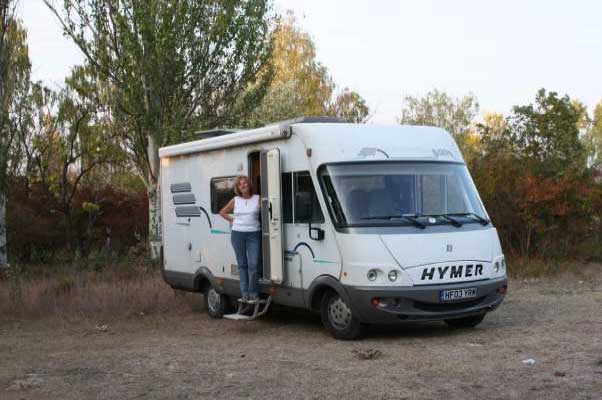Day 34: Tuesday 15th September
Our night is punctuated at regular intervals with the noise of passing trucks. Why? Because it’s a landfill! We find when we get up that the detritus around us is a diverse mixture of stuff – patches of black bags just dumped but lots of individual bits, from household waste to several pairs of pink knickers, just dropped on the roadside. But there are people living nearby – when Harry goes off to look for a place in the trees to bury the cassette waste he finds himself a few metres from someone digging his garden. Nifty footwork and a quiet spade needed there!
By contrast the road from Yalta to Sevastopol is beautiful – stark bare mountains fronted by tree-clad hills. Yesterday’s road was lovely too, but more deciduous trees and autumn colours. Both days we see the country at its best in hot, mostly clear summer weather. As lovely as anything we’ve seen in Greece.
And so into Balaclava, which is (true to the guidebook) on a stunningly beautiful little bay. Our first posh resort too, with some very swish private yachts moored alongside the humbler boats taking passengers out to nearby sandy beaches. There are lots of stalls selling up-market nautical tat, and postcards too. (Evidently Russia doesn’t do postcards so we haven’t sent any, and with a maximum of two weeks to go we decide not to bother buying any now.)
 We climb up to a headland beyond the three Genoese towers which mark the remains of an earlier fortress and admire the view out to sea and back to the town. But not the litter – why don’t they all get together, these sellers of wares, and clean the place up? It would certainly make it qualitatively more attractive. Maybe if you’ve got so much natural beauty around you don’t notice the litter in built-up areas.
We climb up to a headland beyond the three Genoese towers which mark the remains of an earlier fortress and admire the view out to sea and back to the town. But not the litter – why don’t they all get together, these sellers of wares, and clean the place up? It would certainly make it qualitatively more attractive. Maybe if you’ve got so much natural beauty around you don’t notice the litter in built-up areas.
After our walk around the headland we stop for an espresso and fruit tea. We want to see the submarine museum but the directions we get from the waitress are impossible to understand so we just go in the general direction she indicates. Then we see it across the inlet – but how to get there? There seems to be no bridge so we figure you have to go out of Balaclava, round the end of the valley and then back in on the other side. But no, we try that several ways before we realise there MUST be a simpler way. Back into town and a resolve to try each turning starting from the centre outwards. The first one is the right one – signed to the yacht club marina! Another half-hour wasted.
 It’s 25 grivna apiece and we are into an amazing place. An arc of a tunnel hundreds of metres long opening out into a space where Soviet submarines were serviced and repaired. There are odd bits of navy equipment lying around and a big mural showing the good old days. It’s fascinating stuff with many cold-war reminders. The displays showing the history of the port are all in Ukrainian, why are they all so nationalistic now? Then some recent images of the Ukrainian navy on manoeuvres with NATO forces. Russian tourists must seethe.
It’s 25 grivna apiece and we are into an amazing place. An arc of a tunnel hundreds of metres long opening out into a space where Soviet submarines were serviced and repaired. There are odd bits of navy equipment lying around and a big mural showing the good old days. It’s fascinating stuff with many cold-war reminders. The displays showing the history of the port are all in Ukrainian, why are they all so nationalistic now? Then some recent images of the Ukrainian navy on manoeuvres with NATO forces. Russian tourists must seethe.
At one end of the tunnel a big room has been leased to a businessman for the creation of a museum of the Crimean War. This is a must for any visitor to Balaclava (as is the submarine base) as the exhibits are of a high quality, well presented and with many labels in English. A guide shows us around for free. He is practising his English on us, which is not too bad, but we refrain from tipping as it doesn’t seem right.
He is an archaeologist by profession and still goes on many digs for new artefacts – building up his own collection on the side. New finds are regularly made.
The war was an interesting business by all accounts. The aim of the British and French was to stop Russian expansion into Crimea and the Balkans and in this they had an unusual common interest with the Ottoman Turks. Religious affiliations took second place behind realpolitik but a telling painting of soldiers of the three nations show them looking away from each other. The war lasted three years (1854-6) and included Lord Cardigan’s charge of his Light Brigade.
We had been wondering how we would find the ‘diorama’ sited out of town and looking over the famous Valley of Death and the guide gave us clear directions. The first thing we came across was a memorial to the Russian soldiers killed in the war and from there we could see the diorama building up on top of a hill. It took us a little by surprise when we discovered that the whole diorama complex was a war memorial to the heroes of the Sevastopol/Balaclava resistance to the Nazis in WW2, not the Crimean War at all. Nevertheless it was interesting in its own right, with another of those (semi) circular recreations of the battle scene with reconstructed foreground and painted background we had seen in Volgograd, and lots of military equipment on display. Much of this was still in its original position on the hill overlooking the valley. It was easy, then, to imagine the Crimean War scene a century earlier as the Light Brigade made its suicidal attack up the rising valley, defended on three sides by Russian artillery. The museum in Balaclava, and a booklet we purchased, explains in some detail how the fatal attack came about, with misheard orders and lack of clarity on objectives. The ‘fog of war’.
Nevertheless it was interesting in its own right, with another of those (semi) circular recreations of the battle scene with reconstructed foreground and painted background we had seen in Volgograd, and lots of military equipment on display. Much of this was still in its original position on the hill overlooking the valley. It was easy, then, to imagine the Crimean War scene a century earlier as the Light Brigade made its suicidal attack up the rising valley, defended on three sides by Russian artillery. The museum in Balaclava, and a booklet we purchased, explains in some detail how the fatal attack came about, with misheard orders and lack of clarity on objectives. The ‘fog of war’.
As we circled the Russian war memorial’s eternal flame a young boy approached and spat into the flames. His father looked on without reprimanding him. Was this an example of Russian standards slipping or of Ukrainian nationalism?
From here we drive along to Sevastopol but find it impossible to find our way around so we leave town to seek a night spot. The first attempt appears to be OK, out on some farmer’s field. A chap who seems to be on duty to protect the farmer’s grape harvest approaches us and we have a few words and things seem fine. But as we’re mulling over whether this is a good spot or not (as this chap and another appear to be sleeping in a tiny hut just a few metres away) the other chap comes across for a chat. He is plainly paralytic and his attempts at conversation are impossibly incoherent. It doesn’t take long for us to decide we’d feel safer elsewhere – anywhere!
 Just down the road there’s a mini-bus terminal on the edge of woodlands. There’s a track leading from the back of the bus park into the woods. I investigate and find a superb spot under the trees in what appears to be a park set aside specifically for people to camp at their leisure. There are a few houses about 200 metres away and another group or two camping at about the same distance. It is ideal and we settle in for the night without traffic noise, aircraft taking off, barking dogs, or train whistles … We discover the next day that we have gone full circle from the diorama and its entrance is only 250 metres along the road!
Just down the road there’s a mini-bus terminal on the edge of woodlands. There’s a track leading from the back of the bus park into the woods. I investigate and find a superb spot under the trees in what appears to be a park set aside specifically for people to camp at their leisure. There are a few houses about 200 metres away and another group or two camping at about the same distance. It is ideal and we settle in for the night without traffic noise, aircraft taking off, barking dogs, or train whistles … We discover the next day that we have gone full circle from the diorama and its entrance is only 250 metres along the road!
It’s been a lovely warm summer’s day again today and my sandals have dried out from the previous day’s soaking. Not so my jeans, though.
Jill bought some Russian fruit tea bags today for health reasons. We’ll see how long that lasts.

 (share) button at the bottom of your screen,
(share) button at the bottom of your screen, ( Add to Home screen ).
( Add to Home screen ).